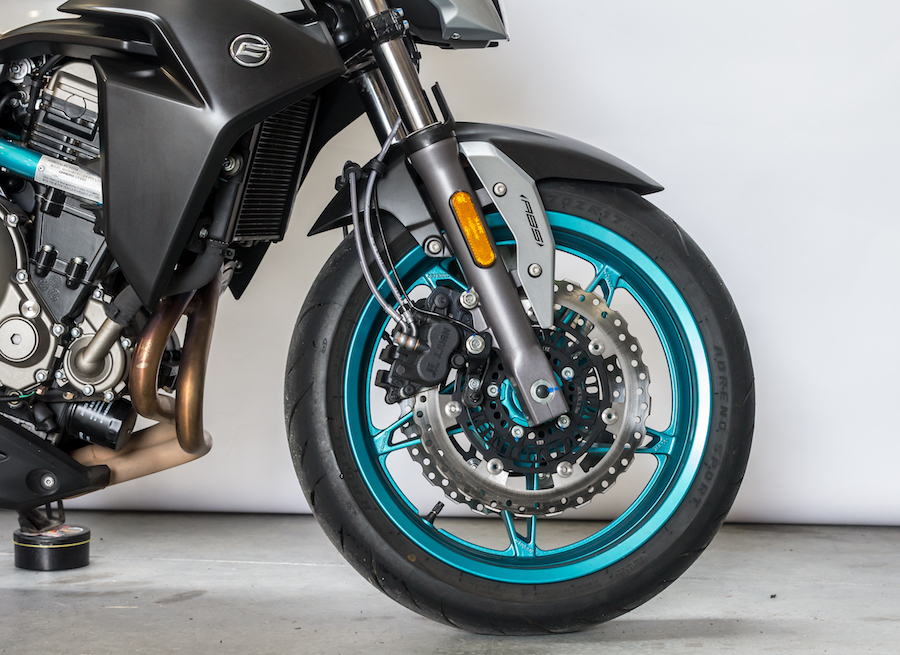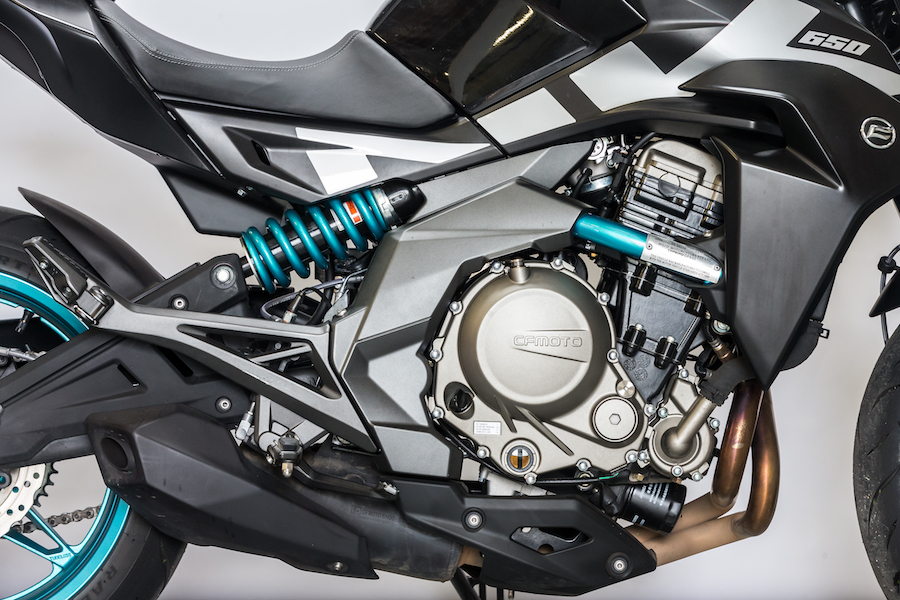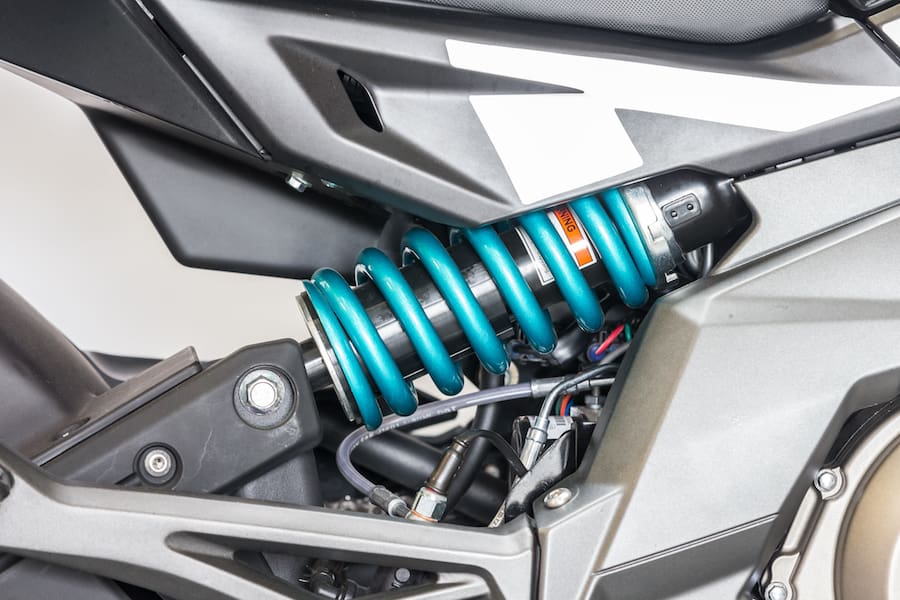Out of the East and shaped by the same hands as KTM’s Beast – these almost identical twins were carved by Gerald Kiska, created by CFMoto, and are coming to a street near you
Chinese manufacturer CFMoto may have only been producing complete motorcycles for 16 years, but it has led the way in improving the reputation of a country sometimes known more for its cheap knock-off items than its premium motorcycles. The low-cost element is still there, but rather than just giving you what you pay for (in other words ‘not much’), as it has been in the past, Chinese bikes increasingly represent an attractive combination of good value, performance, and reliability. By prioritising quality control and in-house R&D investment, and collaborating with established global motorcycle industry heavyweights, CFMoto has been able to propagate its business with the power of a positive reputation. To say this about a Chinese brand 20 years ago would have been highly questionable, but the times they are a ‘changing.
Motorcycles don’t earn the badge of value just by being cheap – the same way expensive bikes can’t be assumed to be of premium quality and performance simply because they cost more than a Brighton beach shack.
I was first educated to CFMoto’s endeavours in improving China’s bad bike rep’ shortly after I arrived at AMCN, three years ago. The first AMCN long-termer on the fleet after the Horror moved south to Melbourne was the previous version of the 650NK. That bike smashed the preconceptions of all who rode it, and served us admirably and reliably despite being quite plainly the office hack, and being subjected to everything from daily commuting to touring, and even trackdays. The worst criticism I could level at it after one of the toughest tours of duty I’ve witnessed from an AMCN long-termer was some minor surface rust here and there on a few bolts and bits’n’pieces. Not bad at all for an everyday Melbourne winter commuter.

That first 650NK’s performance also won praise from the whole AMCN team, and reset expectations on how good a sub $6K 650cc roadbike could be. The bike in this test is essentially a cosmetic update of the original, with some obvious technology improvements such as ABS braking and, apparently, alternative engine maps. Inflation has also dragged the asking price slightly over $6K, but it still lays down a benchmark that’s near-impossible for most manufacturers to emulate.
For 2017 the NK range has expanded to the all-new liquid-cooled single-cylinder 150NK, plus the virtually identical but downsized version of the parallel-twin 650, the 400NK.
So why would CF Moto downsize an engine which was originally built as a 650? Surely you lose some of the benefits of the bigger engine, and the cost of developing a smaller capacity version must make it more expensive too, right? Well, no. The 400NK was developed primarily for CF Moto’s Chinese home market, where such bikes are considered large and powerful, and the vast majority of the staggering 14 million domestic motorcycle sales are of smaller capacity machines, up to 400cc. So how can CFMoto sell the 400NK a grand cheaper than the 650 when it’s essentially the same motorcycle? The answer is in the higher production volumes of the smaller version in China – simple economies of scale.
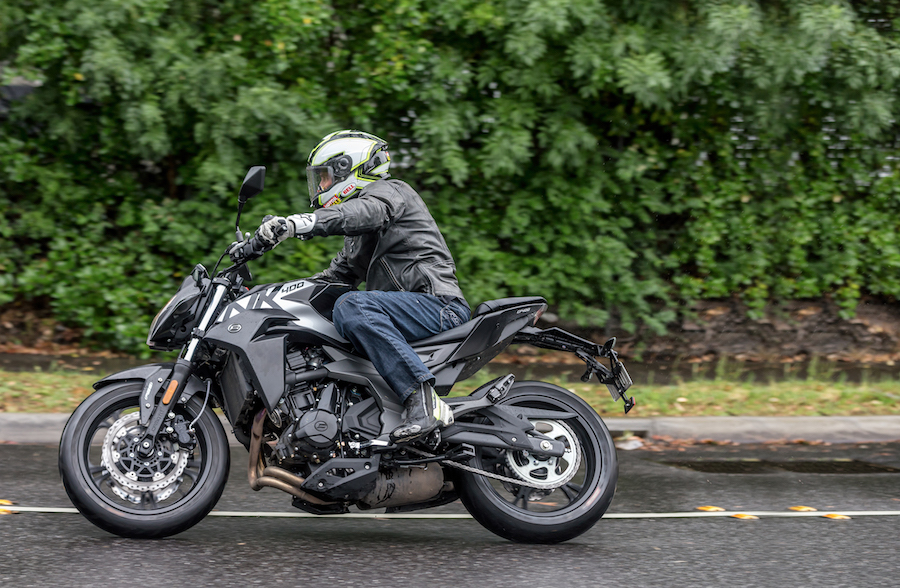
Here in Australia, with our 660cc capacity limit on LAMS motorcycles, both these CFMoto models are learner approved. The big question is: why would Aussie riders choose the mini-NK over the maxi-model? One thousand fun vouchers is a big pull if you are indifferent to power output. And although the margin of mumbo between the two models is considerable, a 400NK will still pull the skin off a rice pudding should the need arise, and being the doppelgänger of its big brother, no street cred is lost in its looks. For inner-city adventures the 400NK is all that’s necessary, and you know this as soon as you ride it. If you’re looking for more out of motorcycling than purely threading the suburban streetscape, then the 650NK has the extra legs to make highway runs practical, and even enticing.
It does seem a bit of an odd thing to do – take a perfectly good bike and making it slower. But the 400NK was always intended for a specific market, where people are not used to shredding the wide-open road in the way we enjoy in the lucky country.

The most surprising thing is the variation in engine characteristics between the two bikes. There is a big power differential, but it’s not just that which sets them apart. Despite visually identical engines, the 400NK doesn’t feel like a scaled-down version of the 650NK – the way it makes power and responds through the rev range is completely different. Whereas the 650NK will pull strongly from around 5500rpm and then taper off from 9000rpm as its LAMS restrictions kick in, the smaller capacity NK doesn’t really get up and rumba until 8000rpm and keeps pulling with relative gusto until the plug is pulled at 11,000rpm, 500rpm higher than the 650’s equally abrupt rev limiter. To give you an idea of just how much the 650’s maximum measured power of 39kW tails off at the top end, both bikes produce 25kW just before they hit their rev limiters, yet at 6000rpm the 650 is pumping out more than twice the kW of its twin sibling with the lower capacity mill.
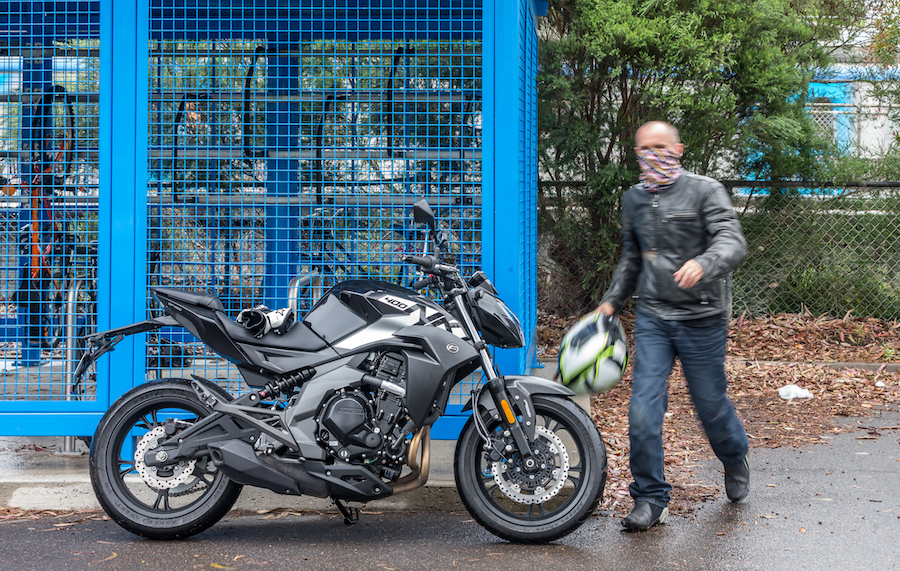
To compensate for its lower power output, the 400NK wears a significantly larger rear sprocket than the 650. This does do a good job of restoring some zip to its acceleration, but also has the knock-on effect of revving the engine higher at cruising speeds – a good 1000rpm or so higher than the 650. This means
the bigger capacity engine does a lot less work across its life, especially when subjected to long stretches at high speed, so anyone intent on regular interstaters or country riding would be best advised to spend the extra money on the 650NK.
Highway hauling on either bike is a comfortable enough chore for someone of my economical dimensions. At 173cm short I’m out of the worst of the windblast even with the NK’s ultra-upright stance. Though I would happily sacrifice 40mm of proximity with the ground for an equal amount of extra seat cushioning. It seems as if ease of footfall for less confident riders has come at the cost of comfort for bony bums.
Taller riders may find the distance between the ’pegs and deeply scalloped saddle a touch on the tight side after a while, although AMCN’s resident jolly giant, Mark Vender, seemed quite content on our test spin (or it may just have been his general delight at escaping the subs desk).
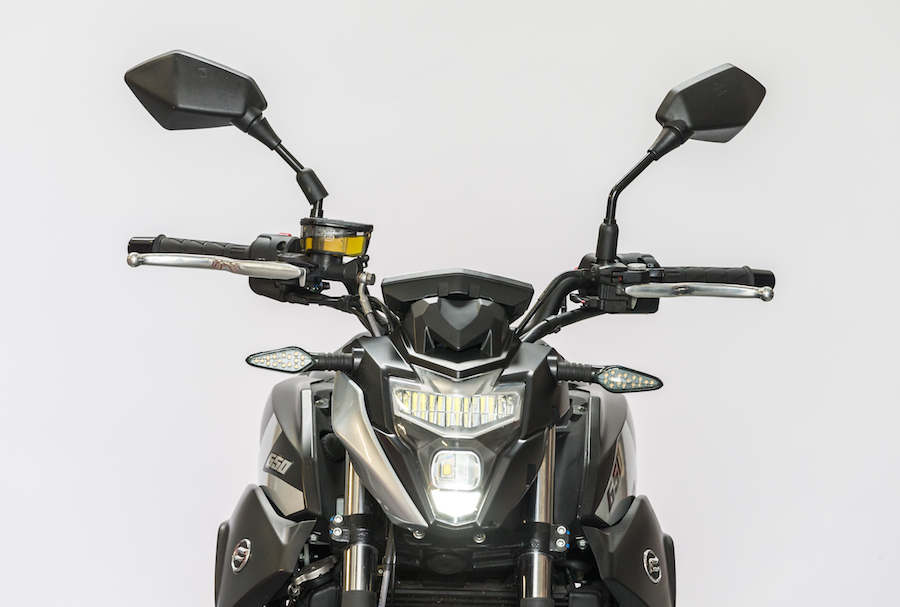
So, does the 400NK languish permanently in the shadow of its big brother, with nothing to offer other than a leaner price tag? Again, no. Where the 400 does excel is in its superior smoothness, and improved fuelling. The 650 is prone to buzz a bit, particularly on the overrun. As this is felt primarily through your inner thighs as you grip the tank, it’s not as irritating as it would be manifested through the ’bars or ’pegs. The 400NK in contrast is as smooth as a silk cheongsam right through the rev range. CFMoto obviously found a better balance when resizing the NK’s 180º phased parallel-twin, both dynamically and also in its fuelling calibration. The smaller engine displays better manners by far when loaded up at low revs, and will pull away cleanly from its idle speed of around 1200rpm, while the 650 doesn’t find its natural rhythm until 3000rpm. So yes, little bro does have a few benefits over the big bruiser.
If you think there’s something familiar about the new CFMoto styling, you’re right. The new NKs have a contemporary, angular look similar to KTM’s roadbike range. Not so surprising, since Kiska design is behind both. But the connection goes even deeper. CFMoto also distributes KTM motorcycles to the Chinese market under the banner of KTMR2R. These are imported as knockdown kits and assembled in China by CFMoto. The fact that a serious competitor like KTM has put its reputation in the hands of another firm is a strong endorsement indeed.
Chassis specs of the two NK models are listed as identical. Both come with the same CFMoto-badged, KYB-made non-adjustable fork, and the same KYB rear monoshock with adjustable rebound damping.
The braking system on the two bikes is identical, with J.Juan calipers biting twin 300mm discs up front and a 240mm disc out back, modulated via steel braided hoses by a Continental ABS system. Barcelona-based braking component company J.Juan supplies CFMoto from its Shanghai factory, and is steadily making inroads into the Asian motorcycle scene where it now enjoys a healthy 20 per cent of the market.
These partnerships are helping CFMoto change the view of Chinese motorcycles. Kiska Design, J.Juan,
KYB, plus the ABS unit supply and development partnership with German giant Continental, all show that CFMoto is looking beyond its own shores for the technology to produce quality globally mainstream motorcycles. And doing this while maintaining a big price advantage is impressive. Some Chinese-made bikes aren’t cheap enough to warrant the risk, but these CFMotos represent a damn good deal, which only the most foolish of brand snobs could overlook.
Chassis geometry isn’t rocket science, it’s fairly simple mathematics only complicated by pesky physics, funky design and human foibles. And it’s relatively easy to get right, as long as the engineers don’t get bored and try to push the boundaries and their luck. CFMoto has done the wise thing and gone for well-worn and trustworthy angles and dimensions with the NK’s frame. It has also kept weight distribution nice and central, with around one per cent front-end bias for sharp positive steering and quite a sporty disposition. The Kawasaki engine on which the NK’s donk is so unashamedly based seems to work well in a wide array of chassis applications, and the CFMoto version appears to carry the same favourable design characteristics.
A total weight of 209kg fully fuelled isn’t superlight by any means, but fairly average for a mid-capacity naked. Its low seat height ensures the weight seems less than the scales would claim when you’re on board, and it accommodates riders short in stature and/or low on experience.
The acutely swept-back ’bars are narrower than usual for a modern day nakedbike, and so lack leverage for fast direction changes when the road starts to snake, but on the upside they’re perfect for scything through city traffic. The ’bars are also high in relation to the seat, and while again this doesn’t feel advantageous in the twisty bits, it promotes an ultra-upright riding position which is ideal for a bike which will spend most of its life serving an urban commuter, giving the rider a meerkat’s perspective of the road hazards ahead.
I was surprised to the point of a severe eyebrow raise to see a ‘map switch’ on both NKs, and not surprised in the slightest when I failed to feel any difference in throttle response whatsoever between the supposed Economy and Sport maps. Neither was a difference in output detected on the dyno. But it’s a nice touch of barstool bullshit to pull out when mean-hearted and ignorant folk are deriding your ride and mocking its lack of tech, clearly proven by a deficiency of acronym stickers. “It’s got bloody powerband maps mate! Your round innit?”
Same same but different
Interior
The smaller NK’s engine achieves a total capacity of 400.4cc with a reduced bore and stroke of 68.4 x 54.5mm, and has a lower compression ratio than the 650NK.

At 83 x 60mm bore and stroke, the 649.3cc engine’s stroke is around 7.4 per cent shorter relative to its capacity than the 400NK, but due to its LAMS restrictions doesn’t get to take full advantage of a short stroke engine’s potential ability to breathe better at higher rpm. In unrestricted form, the 650NK will continue to produce power all the way to the rev limiter, with a maximum output of around 52kW along with the wider spread. Sadly, there are no plans to bring a full power model to Australia. As to whether it’s possible to derestrict the 650NK for riders with full licences … Well, it would be totally irresponsible of a man in my position to say. So best ask someone less responsible than me, if such a person exists. Dyno Dave at Dynobike in Moorabbin might be a good guy to quiz on such matters. But always remember to read your factory warranty agreement very carefully, and perhaps also study the entire type approval regulations for motorcycles sold in Australia, just to be sure you know the consequences. Then do as you please.
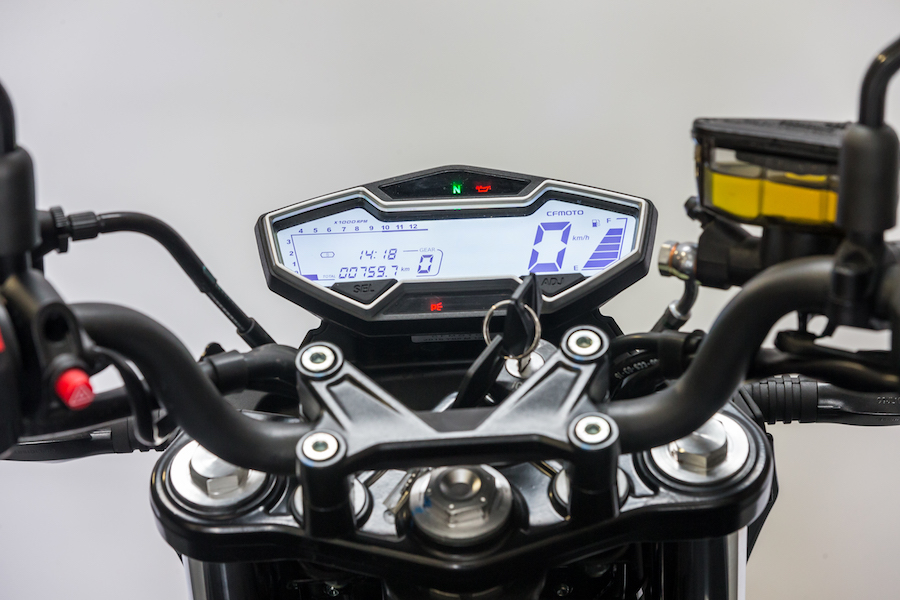
Exterior
Both models share the same tubular steel frame, which uses the engine as a fully stressed member. The conventional fork common to both models is produced by KYB, obviously an exclusive supply to CFMoto since the fork’s lower leg is boldly emblazoned with the bike manufacturer’s name.
It’s reassuring to see twin 300mm brake discs gracing the front of both models. A single disc up front would be an easy cost saving exercise, but any bike of this weight and potential speed warrants the extra stopping power. It also ensures the steering tracks straight and true under heavy braking without the need for substantial fork bracing. Steel braided brake hoses come as standard, and while the brake pad material feels like it has been chosen for its durability rather than its bite, it hasn’t been at the expense of adequate braking performance. The Continental ABS system does its job as safety officer, and does it quite well, but couldn’t ever be described as sophisticated or smooth.
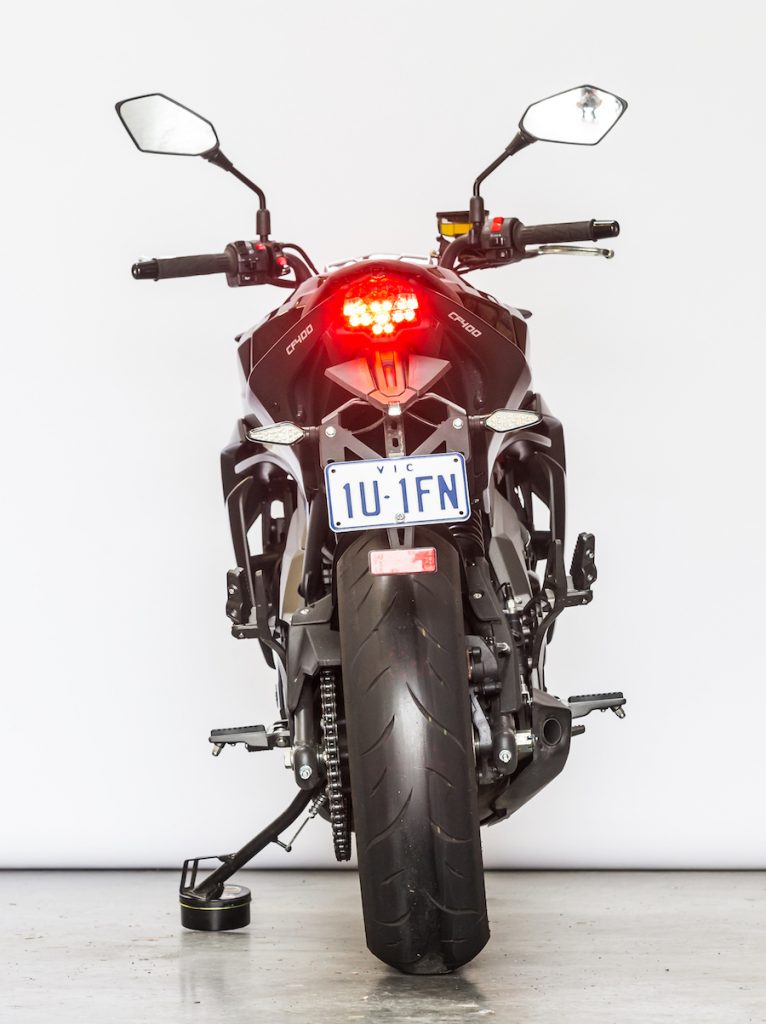
Chinese brand CST isn’t renowned for its sports tyres, and I have to admit to being a little cautious when I first started attacking corners on the NKs.But the aptly named CST Adreno radials never gave a moment of doubt or vagueness in wet or dry.
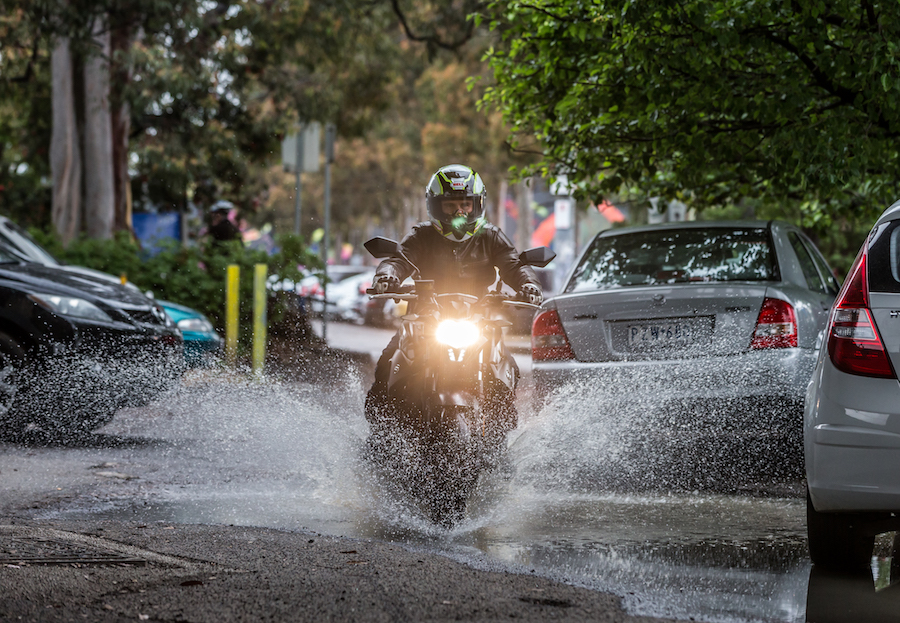
Second Ops
Mark Vender
He may frown a lot, but Mr Young is a softy at heart. While orchestrating the recent MOTY ride on very non-learner bikes, he somehow found room in the van for the 650NK and then pointed me in the direction of the Forrest-Apollo Bay Road with orders to ‘go have some fun’. I duly followed his instructions.
The 650NK was a joy to ride along those twisting roads, with more than enough grunt for a LAMS rider right through the rev range, reassuringly powerful brakes, easy handling and an upright postition with scope for leaning into the ’bars.
Back in Melbourne I found it an excellent commuter – thin enough to filter to the front of the queue, and punchy enough to blast away. I tried the 400NK too, but was underwhelmed by the engine. For $1000 more, it’s gotta be the 650.
The bigger question is, will the price woo buyers away from the traditional big boys? Granted, these CFMotos do not have the wow factor – or the premium performance – of an MT-07 or Street Triple, but they’re also five or six grand less – around half the price. For such a competent bike, it’s a hard offer to ignore.

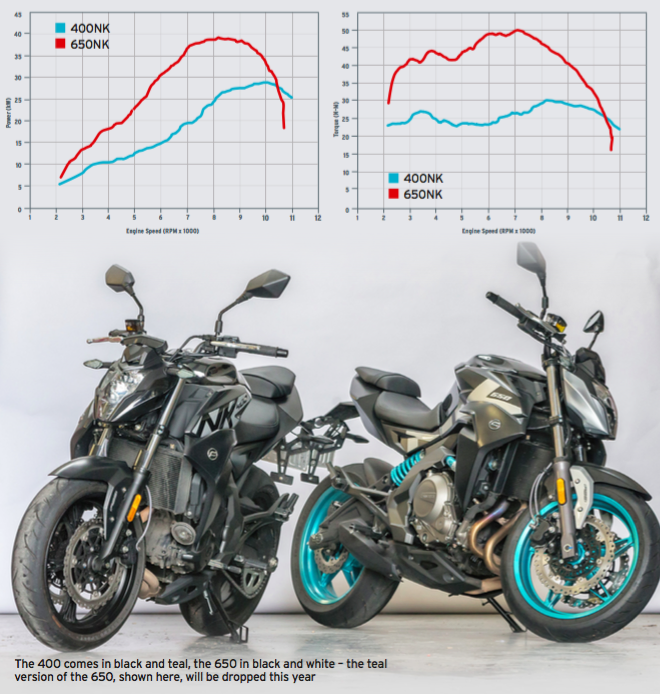
TEST PAUL YOUNG PHOTOGRAPHY MARK DADSWELL

